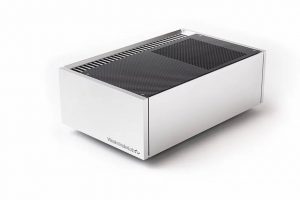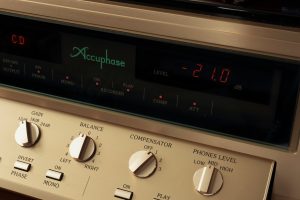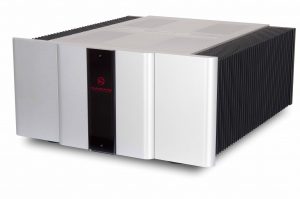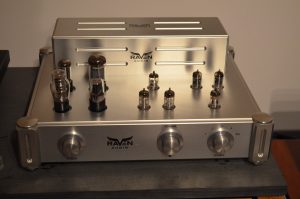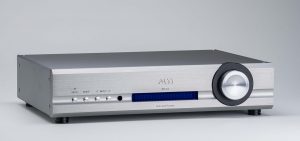My memories from (I think) the first edition of High End Show in Munich (after it moved from Frankfurt's Kempinsky Hotel), survived in few "capsules". Each of them contains a part of me, but also – as I can see it now – sort of prelude to the future events. That's what happened in 2005 in Munich where I met for the first time (among others) Mr Fabio Camorani, the owner of AudioNemesis, Ms Eunice Kron, chief of KR Audio, Mr Hervé Delétraz—the boss of darTZeel and many, many others. It was also then when I first talked to Dirk Sommer, who, at the time, was a Chief Editor of Image Hi-Fi (coverageHERE), and today is a Chief Editor of hifistatement.net.
A year later even though I'd known many of them already for a year, their approach was still about the same. They were still nice, friendly and very professional but they still didn't see Poland as a market for their top products (coverage HERE).

The Polaris preamplifier, in its few versions, has been a part, or rather a heart, the key element of my reference system since 2009, meaning since my review that was published in "High Fidelity" in April that year (issue No. 60, see HERE). Over this time it underwent several upgrades.
A little while later Gerhard with his engineers developed a completely new power supply, well—a power conditioner actually, still using tubes and generating high voltage sinusoid for signal tubes. Improvement of sound quality was significant but the character of the sound remained the same. I had no choice but to upgrade my preamplifier by purchasing the new power supply. The new version was now called Polaris III.
But I knew then already that sooner or later I would have to get myself Ayon's top of the line preamp. So even when Ayon presented Polaris IV, despite the fact I appreciated another progress of performance it introduced, I still wanted Spheris III.
The prototype of this device premiered in Munich in 2013 and the same unit was a part of a system awarded with Best Sound Audio Show 2013. It took Ayon another year to finalize the production of this device. I have received one of the first production units for a review. And it stayed for good…
GERHARD HIRT

In the year 2000 one of the developers of my single-ended amplifiers visited me with a prototype of a free-wired preamplifier mounted on a wooden board. He succinctly asked me to completely unbiased listen to "the thing". It always was his hobby to make experiments with exceptional and crazy concepts (on this board he has worked secretly for almost 8 years, and he never mentioned about it) and he knew all our top preamplifiers very well we were distributing at that time. Actually he also made the service of all foreign brands.
What I heard then completely turned upside down all my imaginations of the previous preamps. Abruptly also tonally many things were different, an airiness, speed, incredible sound colors, plenty of transparency and deep dimensional picture and everything so tangibly true or a spatiality I did not know before - and this from a "wooden board model" with simplest components, barely enough to make it work.
Spheris I (first version, with small power supply) – High End 2006, Munich
5 more years passed until all critical points were finished or solved and the first serial Spheris was put on the market in 2005. We had never thought, that we had to go into so many uncharted waters to reach technical maturity; incredibly many difficulties as every piece in the preamp had a big influence on the sound, many in-house purpose-built items as the design was completely different from everything previously known; we even had to change the housing and the layout 3 times until we were completely satisfied.
This stimulated us further to promptly improve the original design and its peripherals around this circuitry.

Then came the next milestone: the step-switched 4-channel ELMA volume potentiometer with 192 resistors of the Spheris I had to be replaced. There was only one acceptable solution: super-permalloy transformers placed on the output (not one resistor in the volume control system); an extreme challenge as here a completely different requirement (voltages) had to be considered; in the sense of being different from positioning the volume control at the input as is the case of almost every conventional preamps. We used up an enormous number of test equipment of step-up transformers until the right tonal combination of number of coils and transformation etc. became evident.
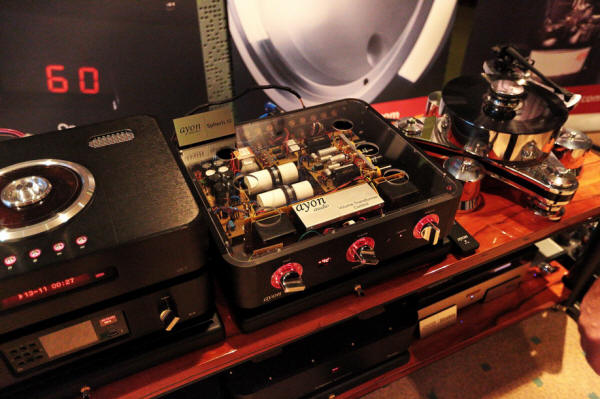
But there was still another "little something" that annoyed us to make the Spheris II absolutely perfect down to the very last detail; we wanted a volume control without any mechanical switching support via potentiometer. The idea was to drive the 4 super permalloy step up transformers not by means of a mechanical potentiometer (Spheris II) but by a sophisticated electronic control system. Consequently, we needed an encoder instead of a mechanical pot, every single super permalloy transformer got its PCB with 24 reed relays each and an MCU with special software (i.e. in total 96 relays an 4 MCU components). This MCU receives the switching signals from the encoder potentiometer, processes them accordingly and with every operation always switches 8 relay contacts with a switching speed of 2/1000th seconds.
Thus, the most complex volume control ever incorporated into a tube preamplifier was born.
As of today the Spheris III really nor reasonably cannot be improved anymore; it is matured in itself for almost 23 years and brought to perfection as perhaps no other series tube preamplifier on the actual world market.
Recordings used during test (a selection)
• Bill Evans Trio, Waltz for Debby, Riverside Records/Analogue Productions APJ009, "Top 25 Jazz", Limited Edition #0773, 2 x 180 g, 45 rpm LP (1961/2008).
• Chet Baker Quartet, Chet Baker Quartet feat. Dick Twardick, Barclay Disques/Sam Records, "Limited Edition", 180 g LP (1955/2011).
• Depeche Mode, Ultra, Mute/Sony Music Labels, Blu-spec CD2, (2007/2014).
• Leonard Cohen, Popular Problems, Sony Music Labels SICP-4329, CD (2014); review HERE.
• Miles Davis Quintet, Relaxin' With The Miles Davis Quintet, Prestige/Universal Music LLC (Japan) UCCO-40005, Platinum SHM-CD, (1958/2013)
• Queen, Queen Forever, Virgin/Universal Music LLC (Japan) UICY-15347/8, 2 x SHM-CD (2014).
One can't really overrate preamplifier's role in audio system. From time perspective I can now see that preamplifier shapes the final sound in a way that is more difficult to perceive (unlike when one changes amplifier, speakers, or source). But it is a preamplifier that plays the key role, that sets a sonic direction for the whole system. In my opinion top models of speakers of most brands aren't really their best ones, when it comes to amplifiers and digital sources sometimes top models are the best and sometimes they are not, but when it comes to preamplifiers flagships always offer top performance.
Spheris III is not only Ayon's flagship linestage but it is also one of the best linestages I've listened so far to. What's more—the set of features it brings to the table, the way it shapes the sound of my system is almost perfectly "tailored" to my needs and expectations. In other words, Spheris III is a perfect addition to "High Fidelity's" reference system making it complete. I am sure that it is still possible to create even better device, and I am sure it will be developed. But I also realize that it will be very, very difficult and it will take a lot of time. How do I know that? Well, I've been waiting for Spheris III in its today's form for 10 years!
What we get is always sort of approximation of reality and an artistic creation at the same time. People responsible for it are: musicians, producers, sound engineers, and also (especially when it comes to pop music) record labels. It so happens that we, audiophiles, attribute significant role also to companies manufacturing the final audio medium, or selling audio file.
Spheris III allows listener to hear or understand exactly what I am talking about. It adds some density, richness to the sound, it increases the depth of the sound. That means it modifies sound in such a way to fit a huge church, stadium, or a large club into a very limited space listener has in his room. I like that! That's what I want/need/expect. I think that this sort of sound modification is the right one for a high-end audio in general. It allows a system to convey more layers of music.
Spheris III in this aspect is a totally different device. Only the above mentioned Mark Levinson came close (among linestages I reviewed). And on top of that Ayon offered also this immense richness of the sound that Levinson couldn't quite match.
With Spheris there are large, very distinct, palpable, intense phantom images rendered in space. Each of them combines many layers that overlap one another to create something that I would describe as "natural" sound, assuming that "natural" means: causing impressions similar to those we experience during live concert. That means that this "artificiality" of music reproduction is somehow not an issue here. It is still not the same thing as "live music", it is "an impression of naturalness". One listens to the music and gets sucked in.
It wasn't cold, emotionless sound that we get—unfortunately—from most passive preamplifiers or from sources with adjustable output signal level (with some exceptions like from: dCS and Ancient Audio). Those devices do homogenize those small differences to even larger extent. They don't really differentiate them, they try to "carve" those differences out and that has nothing to do with music, it might, at most, has to do with technical issues.
Before I wrote this review I had listened to Spheris III for a few months, using it in combination with different systems and different speakers. And before that I had listened to it couple of times during shows in yet another systems. So I could keep writing about it for a long time. But it would be pointless really —if you decide to treat seriously what you have already read, putting for a moment aside a reasonable approach of not completely believing in what you read (which is reasonable and understandable!), if you really ACCEPT what I've already written you already know almost everything you need to about this preamplifier.
It is sometimes hard to understand how in a particular case such a believable holography of the recording was achieved using such a unreliable means that producers had at their disposal. I'd say that we play some active role here too—we just got used to certain way of presentation and, unconsciously, we adapt to it by using or applying our experiences from concerts to what we can hear at home. It kind of replaces what we can really hear. It seems to work really well.
With Ayon soundstage becomes a part of the room and speakers are no longer perceived as sources of the sound. Even when the sounds came directly from the speaker, which happens with some stereo recordings from 50ties and 60ties, I could usually hear them BEHIND speaker, or from the same place in space where the speaker was. If the idea behind particular recording was to surround listener with the sound I truly felt surrounded with it. Sounds coming from behind my head? Absolutely and not only with Roger Waters' Amused to Death but also with some stereophonic Opus3 recordings and some others too. A dense, focused presentation.
It's the richness of the sound, its energy that makes this presentation so emotionally engaging. Almost every recording I listened to was an interesting experience assuming that music was actually interesting, of course. But even these bit boring, or those I'd been avoiding (for whatever reason) became interesting, involving. I can't really image a better recommendation for an audio product.
The point is that each of us has to find his/her perfect fit, like a perfect pair of gloves that fit. If the fit isn't perfect it will bother you on some level and it won't matter whether there will actually be a problem with a glove or a hand. Spheris III is a perfect fit for me. I could easily enjoy music with every of the above mentioned preamplifiers and be really happy about it, but it is Ayon that comes closest to my personal expectations, that is the best "fit" for me and my system. And that's why it has become a part of my reference system. It allows my system to sound in a very pleasant, satisfying way, while still being a useful tool for a reviewer. It encourages me to listen without hiding weaknesses but also allowing me to ignore them. But it is ME who ignores them and not my system, it is my choice. That's the role of a reference system.
AYON AUDIO SPHERIS III
This was a "no-brainer" for me. This device pushes all buttons inside my head that make listening to the music a pure pleasure and a challenge at the same time. This preamplifier works flawlessly with any power amplifier and any source. It is built of innovation and passion. And passion is a bonus we get with it, it is what makes it special and not just another product. This is priceless for every music lover.
The Spheris no. III repeats the idea Ayon used already in 2005 for version no. I—separate casings for power supply and the rest of the device. Starting with no. 'II' casing started to look similar to that of Polaris, i.e. with round corners and all panels made of aluminum. Also large chromed knobs are similar. These allow to select an active input, control volume and set balance between right and left channel. There is an additional element that makes it easy to differentiate Spheris from Polaris—all knobs have a round, red, backlit acrylic bands around them. The backlit can be switched off with a small switch placed on the back of the device. It is so discrete though that I never felt a need to do so. On a front panel there is another new element—a small alphanumeric display showing current volume.
This last element make you wonder—why there is exactly the same knob for volume control taken from version 'II' that sports a large dot that help you to recognize the position of this round knob. This dot was useful before but now the knob controls encoder and just turns round and round. So in fact this dot misleads user.

Sockets are arranged in a different way than in previous versions—before Gerhard used Audio Research's system, with right (red) channel on top, and left (white) below. Most manufacturers use opposite arrangement and this device also uses it.
It is amazingly simple circuit, at least if we consider only a signal transfer. Signal goes from inputs to the PCB with relays. Then, with cables, it goes to the front of the device, to four (two per channel) transformers with multiple tappings. Signal level is changed via change of ratio between primary and secondary winding. It is the same solution as the one used in Music First Audio preamplifiers for example.
Transformers with classic core are made by Ayon in-house, and to switch windings they used an innovative system of relays instead of mechanical switch they used previously. And finally signal reaches tubes, and than the output via a single large Mundorf MCap Supreme Silver/Gold capacitor. All passive elements were carefully selected during listening sessions and all, obviously, are high class ones. There are Lundahl transformers in the input section—signal from RCA inputs is symmetrized and then processed in balanced form.
The power supply sits in a separate casing but its small part is located in the main casing of the device. There is a large Lundahl choke and two huge polypropylene capacitors that are a part of power supply circuit for anode. There are no electrolytic capacitors in tubes' power supply circuit.
Power supply sports two large (I mean high-power amplifier large) toroidal transformers, shielded with metal covers. The anode voltage is rectified in CV135 tubes, full-wave rectifier, with polypropylene capacitor following. As you can see both channels use the same power supply. It seems that the second transformer supplies a large PCB at the back of main unit's casing, that transforms voltage from power grid into pure sinusoid @ 60Hz. You can see this value displayed on the front panel of the device. Only this "re-generated" voltage is sent to transformer that supplies power to the main unit. This whole circuit is called: AC~ ReGenerator.
This device has a classic Ayon's looks with extremely solid casing, engraved writings on it and anty-vibration feet. It still benefits from a good anti-vibration platform and even more advanced feet – I use Franc Audio Accessories Ceramic Disc Classic. The whole electronic circuit seems very simple from electric point of view but its execution is very complex. Power supply itself is as important as the circuit supplying it.
Spheris III comes equipped with a simple, small remote control that allows user to change volume and use a "mute" function.
Input impedance: > 1 MΩ
Frequency response/Line: 0.5 Hz – 500 kHz
AC~ ReGenerator: max. 300 W
Dimensions Pre (WxDxH): 500 x 430 x 110 mm
Weight (pre & power supply): 43 kg
MADE IN AUSTRIA
Text by Wojciech Pacuła
Images by Wojciech Pacuła | Ayon Audio










